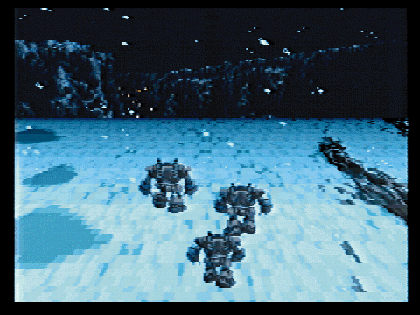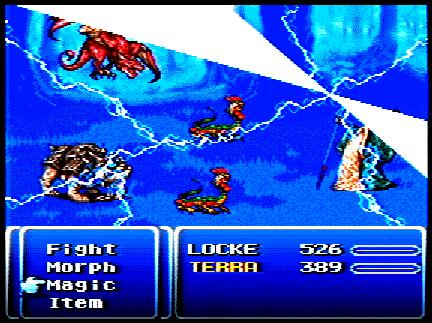 |
Final Fantasy III/VIj
-
Review |
 |
The G.O.A.T. (Greatest
of All Time) By: MrChupon
| Review
Breakdown |
| Battle System |
8 |
| Gameplay |
9 |
| Music |
10 |
| Originality |
9 |
| Plot |
9 |
| Replay Value |
10 |
| Sound |
10 |
| Visuals |
10 |
| Difficulty |
Medium
-
Slightly Difficult |
| Time to Complete |
~40 hours |
|
| Overall |
 |
| Criteria
|
 |
| A march through the snow and the beginning of an epic. |
|
Final
Fantasy III, or VI as it was in Japan, was perhaps the finest
role-playing game Square ever made -- the finest role playing game
ever made, and in my eyes, the finest game ever made.
Maybe you think I'm
taking it far. I want to let you all know that I don't mean
it's best in terms of technical quality, but in sheer enjoyment.
And, at the time, the game was one of the top quality games
technically speaking. I read somewhere that it was the first
Super Nintendo game to make use of its 256-colors on-screen
capabilities. Also, the music was splendidly done, the finest
I'd heard at the time. The gameplay was topnotch. The
story was fun and intriguing. And the ending was worth it.
First, let's talk about
the graphics. As I said above, it may have been the first game
for Super Nintendo that actually utilized its ability to display 256
colors on the screen at the same time. The character sprites
themselves are traditional super-deformed (in other words, just big
heads and small bodies.) But they are well-detailed.
There are little things such as how they bob up and down
realistically when they walk, unlike in the previous games where we
just saw two-framed bland strides. They have cool expressions
-- surprised, downtrodden, laughing, kneeling, and Edgar even has
one where he grins and waggles his finger. The tile-based
scenery is breathtaking. The towns are highly detailed, the
outdoors and dungeons are colorful, and the overworld map utilizes a
mode 7 scaling affect that is a nice quirk. The magic spell
effects were amazing at the time, and still shine today.
But not only do the
graphics in this game shine -- hook your TV to stereo speakers if it
doesn't support stereo, and you'll hear how marvelous a composer
Nobuo Uematsu was in his prime. Each piece of music matches
the scene it's supposed to correspond with (if happy music is
playing while soldiers march across desert, there's something wrong
there), and pulls you into the experience. The varied melodies range
from militaristic, to touching, to dynamic, to even silly. The
MIDI instruments used sounded spectacular for the Super Nintendo
cartridge format; as an EGM editor said way back in 1996, I started
wondering if there was a little tiny CD whirring inside the cart.
Not only was the quality great; the melodies were so varied,
convincing and memorable. (It even simulated an opera scene at
one point!)
 |
| See? Summons don't have to be 2 minutes long to blow your mind. |
|
The
storyline was quite creative. I don't discuss story in order
to keep away any spoilers. It was simple yet deep, both fun
and somber. The storyline wasn't as intriguing as that of
Final Fantasy IV, but still great nonetheless.
The majority of character design and character development was
extremely well done. The characters really do have
personality, rather than just being a boring generic game character
(see Final Fantasy, Final Fantasy Legend, etc.). Unlike most
villains, the ones in this game make you laugh a lot. Look
around for documentation of Kefka and Ultros quotable quotes, and
you'll see what I mean.
The gameplay --
ingenious. Easy to learn, fun to master. Battle commands
are straightforward -- Fight, Item, Magic (once an Esper is
equipped, more on that later), and the character's inherent ability.
No wading through way too complex menus or anything. The most
menus you'll have to trudge through are two. The characters
are well balanced during the whole game (providing that you haven't
been running from every single battle and thus not gaining any
levels, or did the exact opposite).
 |
| Rendered what? Polygon who? |
|
The Esper system is
simple: Equip an Esper once you obtain it, and you can learn
magic and earn status upgrades from it. You learn by obtaining
magic points after battles, and you earn status upgrades after every
level-up. The Accessories system is simple as well, although
most complained it was too simple. I, for one, thought it was
a bit "ho-hum" as well. You equip not only armor,
weapons, etc., but also an accessory which gives you an extra
ability or trait -- invulnerable vs. poison, quicker battle
response, etc. The magic system in battle is typical Final
Fantasy fare -- your characters have a Magic Point reserve that
behaves similarly to your Hit Points: current MP/ maximum MP, and
each spell takes a certain number of MP off your current amount.
Simple and bearable. Not too innovative, but look at the rest
of the game.
 |
| "Er, looks
pretty steep. You wanna check it out for me?" |
|
Final
Fantasy VI is perhaps the most beautifully crafted game on the SNES
-- beautiful visually, aurally, and emotionally. The gameplay
is fun and addictive, calling you back to learn those spells, find
those hidden items, build up those levels and find out what happened
to so-and-so. Nostalgia doesn't need to drag me back to play
this game. This game should be experienced by RPG fanatics and
neophytes alike. It truly shows plain and simple that a game
doesn't need to be rendered or littered with movies to look pretty
or play beautifully. Square's last SNES Final Fantasy will
always be my favorite RPG of all time, and perhaps favorite game of
all time. Go play. It's waiting for you.
|










